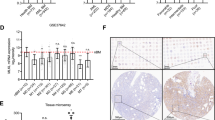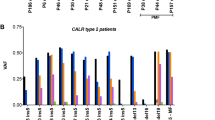Abstract
The requirement that leukemic Gata1 mutations be present in cells harboring trisomy 21 led to the discovery that overexpression of ERG drives aberrant megakaryopoiesis. Given that constitutive PI3K/AKT signaling is a frequent component of hematologic malignancies and the relationship between AKT and Notch in this lineage, we studied the crosstalk between AKT signaling and ERG in megakaryopoiesis. We discovered that constitutive AKT signaling is associated with a dramatic increase in apoptosis of WT megakaryocytes (MKs), but that overexpression of ERG blocks AKT-induced death. We further found that Gata1 mutations protect MKs from activated AKT-induced apoptosis. As a consequence, however, the enhanced signaling inhibits differentiation of Gata1 mutant, but not WT, MKs. Gata1 mutant cells that overexpress ERG with hyperactive AKT are characterized by diminished FOXO1/3a expression and an increased dependency on the c-Jun pathway similar to that seen in acute megakaryoblastic leukemia (AMKL) cell lines, acute myeloid leukemia (AML) with knockdown of FOXO3a, or AML with expression of myristoylated Akt. Additionally, we found that the AKT allosteric inhibitor MK2206 caused reduced cell viability and proliferation of AMKL cell lines. The contribution of aberrant AKT signaling during the ontogeny of Down syndrome-transient myeloproliferative disorder/AMKL indicates that AKT is a therapeutic target in this form of AML.
This is a preview of subscription content, access via your institution
Access options
Subscribe to this journal
Receive 12 print issues and online access
$259.00 per year
only $21.58 per issue
Buy this article
- Purchase on Springer Link
- Instant access to full article PDF
Prices may be subject to local taxes which are calculated during checkout







Similar content being viewed by others
References
Klusmann JH, Godinho FJ, Heitmann K, Maroz A, Koch ML, Reinhardt D et al. Developmental stage-specific interplay of GATA1 and IGF signaling in fetal megakaryopoiesis and leukemogenesis. Genes Dev 2010; 24: 1659–1672.
Malinge S, Ragu C, Della-Valle V, Pisani D, Constantinescu SN, Perez C et al. Activating mutations in human acute megakaryoblastic leukemia. Blood 2008; 112: 4220–4226.
Malinge S, Izraeli S, Crispino JD . Insights into the manifestations, outcomes, and mechanisms of leukemogenesis in Down syndrome. Blood 2009; 113: 2619–2628.
Roy A, Roberts I, Norton A, Vyas P . Acute megakaryoblastic leukaemia (AMKL) and transient myeloproliferative disorder (TMD) in Down syndrome: a multi-step model of myeloid leukaemogenesis. Br J Haematol 2009; 147: 3–12.
Stankiewicz MJ, Crispino JD . ETS2 and ERG promote megakaryopoiesis and synergize with alterations in GATA-1 to immortalize hematopoietic progenitor cells. Blood 2009; 113: 3337–3347.
Muntean AG, Crispino JD . Differential requirements for the activation domain and FOG-interaction surface of GATA-1 in megakaryocyte gene expression and development. Blood 2005; 106: 1223–1231.
Kharas MG, Okabe R, Ganis JJ, Gozo M, Khandan T, Paktinat M et al. Constitutively active AKT depletes hematopoietic stem cells and induces leukemia in mice. Blood 2010; 115: 1406–1415.
Cornejo MG, Mabialah V, Sykes SM, Khandan T, Lo Celso C, Lopez CK et al. Crosstalk between NOTCH and AKT signaling during murine megakaryocyte lineage specification. Blood 2011; 118: 1264–1273.
Sykes SM, Lane SW, Bullinger L, Kalaitzidis D, Yusuf R, Saez B et al. AKT/FOXO signaling enforces reversible differentiation blockade in myeloid leukemias. Cell 2011; 146: 697–708.
Li Z, Godinho FJ, Klusmann JH, Garriga-Canut M, Yu C, Orkin SH . Developmental stage-selective effect of somatically mutated leukemogenic transcription factor GATA1. Nat Genet 2005; 37: 613–619.
Ng AP, Hyland CD, Metcalf D, Carmichael CL, Loughran SJ, Di Rago L et al. Trisomy of Erg is required for myeloproliferation in a mouse model of Down syndrome. Blood 2010; 115: 3966–3969.
Salek-Ardakani S, Smooha G, de Boer J, Sebire NJ, Morrow M, Rainis L et al. ERG is a megakaryocytic oncogene. Cancer Res 2009; 69: 4665–4673.
Tsuzuki S, Taguchi O, Seto M . Promotion and maintenance of leukemia by ERG. Blood 2011; 117: 3858–3868.
Naka K, Hoshii T, Muraguchi T, Tadokoro Y, Ooshio T, Kondo Y et al. TGF-beta-FOXO signalling maintains leukaemia-initiating cells in chronic myeloid leukaemia. Nature 2010; 463: 676–680.
Chapuis N, Park S, Leotoing L, Tamburini J, Verdier F, Bardet V et al. IkappaB kinase overcomes PI3K/Akt and ERK/MAPK to control FOXO3a activity in acute myeloid leukemia. Blood 2010; 116: 4240–4250.
Eppert K, Takenaka K, Lechman ER, Waldron L, Nilsson B, van Galen P et al. Stem cell gene expression programs influence clinical outcome in human leukemia. Nat Med 2011; 17: 1086–1093.
Tothova Z, Gilliland DG . FoxO transcription factors and stem cell homeostasis: insights from the hematopoietic system. Cell Stem Cell 2007; 1: 140–152.
Walters DK, Mercher T, Gu TL, O'Hare T, Tyner JW, Loriaux M et al. Activating alleles of JAK3 in acute megakaryoblastic leukemia. Cancer Cell 2006; 10: 65–75.
Gruber TA, Larson Gedman A, Zhang J, Koss CS, Marada S, Ta HQ et al. An Inv(16)(p13.3q24.3)-Encoded CBFA2T3-GLIS2 fusion protein defines an aggressive subtype of pediatric acute megakaryoblastic leukemia. Cancer Cell 2012; 22: 683–697.
Malinge S, Bliss-Moreau M, Kirsammer G, Diebold L, Chlon T, Gurbuxani S et al. Increased dosage of the chromosome 21 ortholog Dyrk1a promotes megakaryoblastic leukemia in a murine model of Down syndrome. J Clin Invest 2012; 122: 948–962.
Khan I, Malinge S, Crispino J . Myeloid leukemia in Down syndrome. Crit Rev Oncog 2011; 16: 25–36.
Chou ST, Opalinska JB, Yao Y, Fernandes MA, Kalota A, Brooks JS et al. Trisomy 21 enhances human fetal erythro-megakaryocytic development. Blood 2008; 112: 4503–4506.
Izraeli S . Trisomy 21 tilts the balance. Blood 2008; 112: 4361–4362.
Mundschau G, Crispino J . GATA1s goes germline. Nat Genet 2006; 38: 741–742.
Martelli AM, Chiarini F, Evangelisti C, Grimaldi C, Ognibene A, Manzoli L et al. The phosphatidylinositol 3-kinase/AKT/mammalian target of rapamycin signaling network and the control of normal myelopoiesis. Histol Histopathol 2010; 25: 669–680.
Raslova H, Baccini V, Loussaief L, Comba B, Larghero J, Debili N et al. Mammalian target of rapamycin (mTOR) regulates both proliferation of megakaryocyte progenitors and late stages of megakaryocyte differentiation. Blood 2006; 107: 2303–2310.
Liu ZJ, Italiano J, Ferrer-Marin F, Gutti R, Bailey M, Poterjoy B et al. Developmental differences in megakaryocytopoiesis are associated with up-regulated TPO signaling through mTOR and elevated GATA-1 levels in neonatal megakaryocytes. Blood 2011; 117: 4106–4117.
Magee JA, Ikenoue T, Nakada D, Lee JY, Guan KL, Morrison SJ . Temporal Changes in PTEN and mTORC2 regulation of hematopoietic stem cell self-renewal and leukemia suppression. Cell Stem Cell 2012; 11: 415–428.
Yamazaki S, Iwama A, Takayanagi S, Morita Y, Eto K, Ema H et al. Cytokine signals modulated via lipid rafts mimic niche signals and induce hibernation in hematopoietic stem cells. Embo J 2006; 25: 3515–3523.
Miyamoto K, Araki KY, Naka K, Arai F, Takubo K, Yamazaki S et al. Foxo3a is essential for maintenance of the hematopoietic stem cell pool. Cell Stem Cell 2007; 1: 101–112.
Kentsis A, Look AT . Distinct and dynamic requirements for mTOR signaling in hematopoiesis and leukemogenesis. Cell Stem Cell 2012; 11: 281–282.
Acknowledgements
We are grateful to Thomas Mercher for plasmids and Merck for supplying MK2206 and thank the Robert H. Lurie Comprehensive Cancer Center supported Flow Cytometry Core and Cell Imaging Cores at Northwestern University. We also thank Benjamin Goldenson for assistance with CalcuSyn software calculations. This work was supported in part by the Samuel Waxman Cancer Research Foundation and a grant from the NCI (R01CA101774).
Author information
Authors and Affiliations
Corresponding author
Ethics declarations
Competing interests
The authors declare no conflict of interest.
Additional information
Supplementary Information accompanies this paper on the Leukemia website
Supplementary information
Rights and permissions
About this article
Cite this article
Stankiewicz, M., Crispino, J. AKT collaborates with ERG and Gata1s to dysregulate megakaryopoiesis and promote AMKL. Leukemia 27, 1339–1347 (2013). https://doi.org/10.1038/leu.2013.33
Received:
Revised:
Accepted:
Published:
Issue Date:
DOI: https://doi.org/10.1038/leu.2013.33
Keywords
This article is cited by
-
c-Mpl-del, a c-Mpl alternative splicing isoform, promotes AMKL progression and chemoresistance
Cell Death & Disease (2022)
-
Regulatory T cells promote the stemness of leukemia stem cells through IL10 cytokine-related signaling pathway
Leukemia (2022)
-
Pediatric MDS and bone marrow failure-associated germline mutations in SAMD9 and SAMD9L impair multiple pathways in primary hematopoietic cells
Leukemia (2021)
-
Myeloid proliferations associated with Down syndrome
Journal of Hematopathology (2015)
-
The secret life of a megakaryocyte: emerging roles in bone marrow homeostasis control
Cellular and Molecular Life Sciences (2015)



